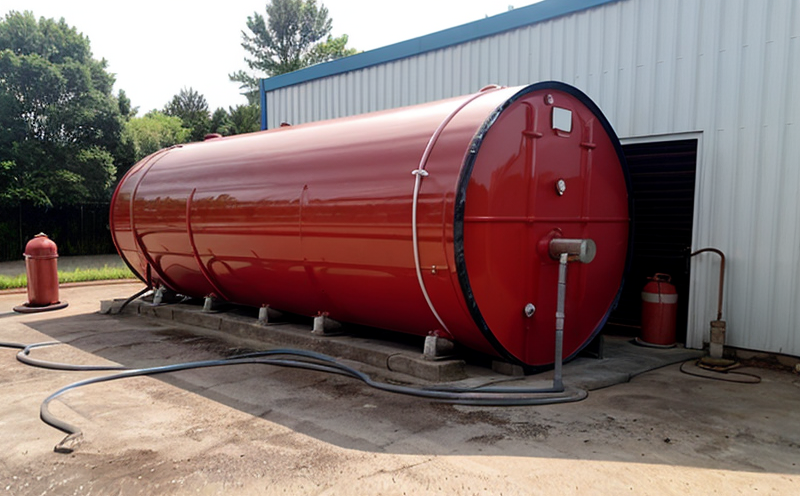Fuel storage tank inspection
Ensuring the safety and integrity of fuel storage tanks is crucial in various sectors such as oil refining, petrochemicals, aviation, and transportation. The primary goal of a fuel storage tank inspection is to assess the structural condition, material integrity, and operational performance of these critical components. This service involves detailed evaluations aimed at identifying potential hazards, ensuring compliance with relevant standards, and preventing costly disruptions or accidents.
Fuel storage tanks are exposed to harsh environmental conditions including temperature fluctuations, pressure variations, and corrosive elements like water and contaminants. Regular inspections help in detecting early signs of degradation such as corrosion, cracks, leaks, and structural anomalies. These issues can lead to significant operational risks, including fuel spills, explosions, and contamination.
The inspection process typically involves a combination of non-destructive testing (NDT) techniques, visual inspections, and sometimes destructive testing for critical areas. Non-destructive testing methods such as ultrasonic testing, magnetic particle testing, eddy current testing, and liquid penetrant testing are used to evaluate the integrity without causing damage. Visual inspections focus on identifying visible defects or anomalies that may not be detectable through NDT alone.
Compliance with international standards is essential for ensuring consistency and reliability in inspection practices. Relevant standards include ISO 17605:2014, ASTM D1391-18, EN 14014, and API 651. These guidelines provide a framework for conducting thorough inspections that meet industry best practices.
| Applied Standards | Description |
|---|---|
| ISO 17605:2014 | Guidelines for non-destructive testing of large storage tanks using ultrasonic methods. |
| ASTM D1391-18 | Standard practice for inspection and evaluation of ferromagnetic surface cracks in carbon steel pressure vessels. |
| EN 14014 | European standard for the integrity assessment of metallic storage tanks. |
| API 651 | American Petroleum Institute specification for design and construction of large storage tanks. |
The inspection process begins with a thorough review of the tank's history, including previous inspections, maintenance records, and operational data. This information helps in identifying areas that require particular attention during the inspection. The inspection team then conducts visual assessments followed by non-destructive testing to evaluate the structural integrity.
Once the evaluation is complete, detailed reports are prepared outlining findings, recommendations for necessary repairs or replacements, and compliance with relevant standards. These reports serve as valuable tools in maintaining safe and efficient fuel storage operations.
Applied Standards
| Standard | Description |
|---|---|
| ISO 17605:2014 | Guidelines for non-destructive testing of large storage tanks using ultrasonic methods. |
| ASTM D1391-18 | Standard practice for inspection and evaluation of ferromagnetic surface cracks in carbon steel pressure vessels. |
| EN 14014 | European standard for the integrity assessment of metallic storage tanks. |
| API 651 | American Petroleum Institute specification for design and construction of large storage tanks. |
The application of these standards ensures that inspections are conducted with precision and adhere to industry benchmarks. Compliance is critical in maintaining operational safety and regulatory adherence.
Competitive Advantage and Market Impact
- Precision: Adherence to strict international standards enhances the accuracy of inspection results.
- Compliance: Ensures that inspections meet regulatory requirements, reducing legal risks.
- Reliability: Regular inspections improve operational reliability by identifying potential issues early.
- Safety: Reduces the risk of accidents and environmental hazards associated with fuel storage tanks.
The demand for reliable and accurate fuel storage tank inspection services is growing as industries strive to enhance safety standards. By providing these services, we contribute significantly to the overall market by ensuring that critical infrastructure remains safe and compliant.
Use Cases and Application Examples
- In oil refineries where fuel storage tanks are exposed to extreme conditions due to high temperatures and pressures.
- In aviation facilities where the integrity of fuel tanks is crucial for flight safety.
- In petrochemical plants that handle large quantities of hazardous materials, ensuring tank integrity prevents leaks and explosions.
| Use Case | Description |
|---|---|
| Oil Refineries | Regular inspections help in maintaining operational efficiency by identifying early signs of degradation. |
| Airports | Ensuring fuel tank integrity is vital for flight safety and airport operations. |
| Petrochemical Plants | Preventing leaks and explosions through timely inspections enhances facility safety and operational reliability. |
The real-world impact of these inspections extends beyond the immediate facility. By ensuring safe fuel storage, we contribute to broader environmental and public safety goals.





